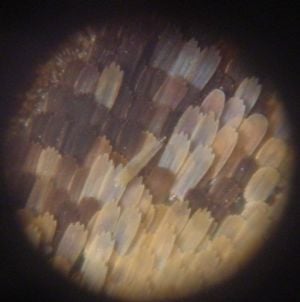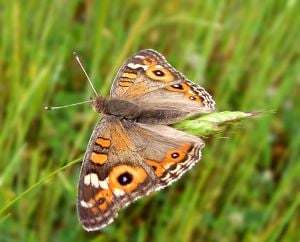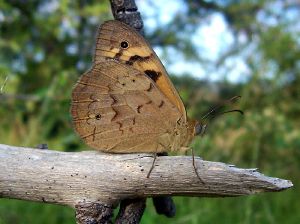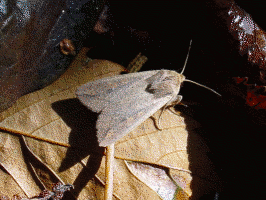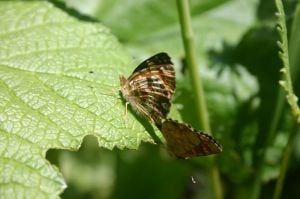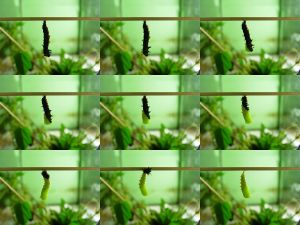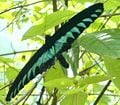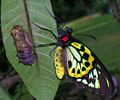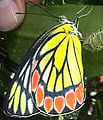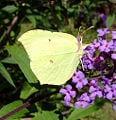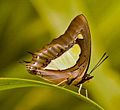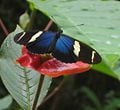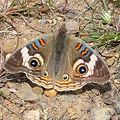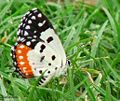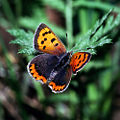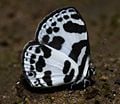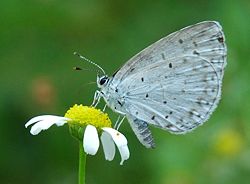Butterfly
| Butterflies | ||||||||||
|---|---|---|---|---|---|---|---|---|---|---|
| Monarch A viceroy butterfly, mimic of the monarch butterfly | ||||||||||
| Scientific classification | ||||||||||
| ||||||||||
| Families | ||||||||||
|
A butterfly is an insect of the Order Lepidoptera that belongs to the superfamily Papilionoidea and usually the superfamily Hesperioidea (the skippers). Some scientists would include also members of the superfamily Hedyloidea, the American butterfly moths. Although the skippers (superfamily Hesperioidea) are usually counted as butterflies, they are somewhat intermediate between the rest of the butterflies and the remaining Lepidoptera, the moths.
People who study or collect butterflies (or the closely related moths) are called lepidopterists. The study of butterflies is known as butterflying. Butterfly watching is growing in popularity as a hobby. An older term for a lepidopterist is aurelian.
Etymology
The Old English word for butterfly was buttorfleoge apparently because butterflies were thought to steal milk. A similar word occurs in Dutch originating from the same belief. This is believed to have led to the development of its present name form: butterfly.
An alternative folk etymology, current in Great Britain, is that it originated as a contraction of term butter-coloured fly referring to the Brimstone Butterfly Gonepteryx rhamni, often the first butterfly of Spring. Earlier, it was mistakenly considered that the word butterfly came from a metathesis of "flutterby".
Butterfly scales
Butterflies belong to Lepidoptera or scaly-winged insects (lepidos = scales and pteron = wings in Greek). Butterflies have fine scales on their wings that look like a fine powder. These scales are colored and result in giving striking colors and patterns to many butterflies while providing cryptic colors and camouflage patterns to others. When touched by humans, the wings tend to lose some scales. If too many scales are lost, the butterfly's ability to fly will be impaired. The scales on the butterfly wings have many properties, mostly optical, that interest scientists. The pattern they make are also seen as the best animal system for understanding the developmental and genetic processes that produce morphological variation in nature.
Butterflies have been used as model organisms for a variety of fields of study, spanning ecology, evolutionary biology, and conservation biology (Boggs et al. 2003). Much of the theory on aposematism and mimicry arose from nineteenth century studies by lepidopterists studying butterflies in the New World and the Orient. Considerable research by H. F. Nijhout and others have been done on developmental biology that have provided insights into the development of color patterns in butterfly wings.
Classification
Presently butterflies are classified in two superfamilies, Hesperioidea, consisting of the 'skippers' and Papilionoidea or 'true butterflies'. These are sister taxa, so the butterflies collectively are thought to constitute a true clade. Some modern taxonomists place them all in superfamily Papilionoidea, distinguishing the skippers from the other butterflies at the series level only. In this system, Papilionoidea consists of the series Hesperiiformes (with one family only, the skipper family Hesperiidae) and the series Papilioniformes (with five families).
Skippers are classified in the superfamily Hesperioidea, which includes only one family, the Hesperiidae. They differ in several important ways from the remaining butterflies, which are classified in superfamily Papilionoidea. Skippers have the antennae clubs hooked backward, have stocky bodies, and possess stronger wing muscles and better eyes. Nonetheless, the two superfamilies are regarded as sister taxa, so the butterflies collectively form a true clade. In fact, some taxonomists place the family Hesperiidae within the superfamily Papilionoidea.
Butterfly families
The five families of true butterflies usually recognised in the Papilionoidea are:-
- Family Papilionidae, the Swallowtails and Birdwings.
- Family Pieridae, the Whites and Yellows.
- Family Lycaenidae, the Blues and Coppers, also called the Gossamer-Winged Butterflies,
- Family Riodinidae, the Metalmark butterflies,
- Family Nymphalidae, the Brush-footed butterflies,
Some common/well known butterfly species
There are between 15,000 and 20,000 species of butterflies worldwide. Some well known species from around the world include:-
- Swallowtails and Birdwings, Family Papilionidae
- Common Yellow Swallowtail, Papilio machaon
- Spicebush Swallowtail, Papilio troilus
- Lime Butterfly, Papilio demoleus
- Ornithoptera genus (Birdwings; the largest butterflies)
- Whites or Yellows, Family Pieridae
- Small White, Pieris rapae
- Green-veined White, Pieris napi
- Common Jezebel, Delias eucharis
- Blues and Coppers or Gossamer-Winged Butterflies, Family Lycaenidae
- Xerces Blue, Glaucopsyche xerces
- Karner Blue, Lycaeides melissa samuelis (endangered)
- Red Pierrot, Talicada nyseus
- Metalmark butterflies, Family Riodinidae
- Lange's Metalmark Butterfly
- Plum Judy, Abisara echerius
- Brush-footed butterflies, Family Nymphalidae
- Painted Lady, or Cosmopolite, Vanessa cardui
- Monarch butterfly, Danaus plexippus
- Morpho genus
- Speckled Wood, Pararge aegeria
Difference between butterflies and moths
Butterflies and moths are often confused with each other. Although there are many ways of distinguishing a butterfly from a moth, there are exceptions to every rule, and it is perhaps better to think of butterflies as a group of day flying moths.
Taxonomic issues
A major new study (Wahlberg et al., 2005) combining morphological and molecular data concluded that Hesperiidae, Papilionidae, Pieridae, Lycaenidae and Riodinidae could all be strongly supported as monophyletic clades, but the status of Nymphalidae is equivocal. Lycaenidae and Riodinidae were confirmed as sister taxa, and Papilionidae as the outgroup to the rest of the true butterflies, but the location of Pieridae within the pattern of descent was unclear, with different lines of evidence suggesting different conclusions. The data suggested that the moths of Hedyloidea are indeed more closely related to the butterflies than to other moths.
Some older classifications recognize additional families, for example Danaidae, Heliconiidae, Libytheidae and Satyridae, but modern classifications treat these as subfamilies within the Nymphalidae.
The four stages in the lifecycle of a butterfly
Unlike many insects, butterflies do not experience a nymph period, but instead go through a pupal stage which lies between the larva and the adult stage (the imago).
- Egg
- Larva, known as a caterpillar
- Pupa (chrysalis)
- Adult butterfly (imago)
Egg
Butterfly eggs consist of a hard-ridged outer layer of shell, called the chorion. This is lined with a thin coating of wax which prevents the egg from drying out before the larva has had time to fully develop. Each egg contains a number of tiny funnel-shaped openings at one end, called micropyles; the purpose of these holes is to allow sperm to enter and fertilize the egg. Butterfly and moth eggs vary greatly in size between species, but they are all either spherical or ovate.
Butterfly eggs are fixed to a leaf with a special glue which hardens rapidly. As it hardens it contracts deforming the shape of the egg. This glue is easily seen surrounding the base of every egg forming a meniscus. The nature of the glue is unknown, and is a suitable subject for research. The same glue is produced by a pupa to secure the setae of the cremaster. This glue is so hard that the silk pad, to which the setae are glued, cannot be separated.
Caterpillars
Larvae, or caterpillars, are multi-legged eating machines. They consume plant leaves and spend practically all of their time in search of food.
Caterpillars mature through a series of stages, called instars. Near the end of each instar, the larva undergoes a process called apolysis, in which the cuticle, a mixture of chitin and specialized proteins, is released from the epidermis and the epidermis begins to form a new cuticle beneath. At the end of each instar, the larva moults the old cuticle, and the new cuticle rapidly hardens and pigments. Development of butterfly wing patterns begins by the last larval instar.
Wing development in larval stage
Butterflies belong to the specialized and prolific lineage of holometabolous insects, which means that wings or wing pads are not visible on the outside of the larva, but when larvae are dissected, tiny developing "wing disks" can be found on the second and third thoracic segments, in place of the spiracles that are apparent on abdominal segments.
Wing disks develop in association with a trachea that runs along the base of the wing, and are surrounded by a thin "peripodial membrane", which is linked to the outer epidermis of the larva by a tiny duct.
Wing disks are very small until the last larval instar, when they increase dramatically in size, are invaded by branching tracheae from the wing base that precede the formation of the wing veins, and begin to express molecular markers in patterns associated with several landmarks of the wing.
Near pupation, the wings are forced outside the epidermis under pressure from the hemolymph, and although they are initially quite flexible and fragile, by the time the pupa breaks free of the larval cuticle they have adhered tightly to the outer cuticle of the pupa (in obtect pupae). Within hours, the wings form a cuticle so hard and well-joined to the body that pupae can be picked up and handled without damage to the wings.
File:Chrysalis5504.JPG Chrysalis of Gulf Fritillary |
Pupa
When the larva exceeds a minimum weight at a particular time of day, it will stop feeding and begin "wandering" in a quest for a suitable pupation site, usually the underside of a leaf. The larva transforms into a pupa (chrysalis), which then transforms into a butterfly by metamorphosis. To transform from the miniature wings visible on the outside of the pupa into large structures usable for flight, the pupal wings undergo rapid mitosis and absorb a great deal of nutrients. If one wing is surgically removed early on, the other three will grow to a larger size. In the pupa, the wing forms a structure that becomes compressed from top to bottom and pleated from proximal to distal ends as it grows, so that it can rapidly be unfolded to its full adult size. Several boundaries seen in the adult color pattern are marked by changes in the expression of particular transcription factors in the early pupa.
Adult Butterfly or Imago
The adult, sexually mature, stage of the insect is known as the imago. As Lepidoptera, butterflies have four wings that are covered with tiny scales (see photo), but, unlike moths, the fore- and hindwings are not hooked together, permitting a more graceful flight. A butterfly has six legs; the larva also has six true legs and a number of prolegs. After it emerges from its pupal stage, it cannot fly for some time, because its wings have not yet unfolded. A newly-emerged butterfly needs to spend some time 'inflating' its wings with blood and letting them dry, during which time it is extremely vulnerable to predators.
Polymorphism
Many butterflies exhibit a wide range of polymorphism - ranging from highly visible morphological variation, such as in the form of races, varieties, polymorph female forms, mimetic forms, sexual dimorphism, to externally indistinguishable forms such as variation in body chemistry and anatomy of sexual parts.
Many species of butterfly are sexually dimorphic.
Batesian mimicry and Mullerian mimicry in butterflies is common.
Genetic abnormalities such as gynandromorphs also occur from time to time.
Habits
Butterflies live primarily on nectar from flowers. Some also derive nourishment from pollen, tree sap, rotting fruit, dung, and dissolved minerals in wet sand or dirt. Butterflies play an important ecological role as pollinators.
As adults, butterflies are able to consume liquids only by means of their proboscis. They regularly feed on nectar and sip water from damp patches. This they do for water, for energy from sugars in nectar and for sodium and other minerals which are vital for their reproduction.
Several species of butterflies need more sodium than provided by the nectar they drink from flowers. As such, they are attracted to the sodium in salt (which the males often give to the females to ensure fertility). As human sweat contains significant quantities of salt, they sometimes land on people, to the delight of the young at heart everywhere.
Besides damp patches, some butterflies also visit dung, rotting fruit or carcasses to obtain the essential minerals that they need.
Butterflies sense the air for scents, wind and nectar using their antennae. The antennae come in various shapes and colours. The hesperids have a pointed angle or hook to the antennae.
Some butterflies, such as the Monarch butterfly, are migratory.
Aerodynamics, butterflies, and flutter
Unlike many other members of the insect world, the flight of a butterfly can be explained quantitatively (and quite accurately) using steady-state, non-transitory aerodynamics. The aspect ratio of a butterfly's wing is ideal to be described using thin airfoil theory. The fluttering of the wings merely serves to enforce the Kutta condition of low-speed aerodynamics. For a more detailed description, see Insect flight.
Additional photos
Family Papilionidae- The Swallowtails
Family Pieridae - The Whites and Yellows
Family Riodinidae - The Metalmarks, Punches and Judies
- Abisara echerius1.jpg
The Plum Judy,
Abisara echerius
Family Nymphalidae - The Brush-footed Butterflies
Family Lycaenidae - The Blues
See also
- List of British butterflies
- List of official state butterflies for each state of the U.S.A.
- List of butterflies of India
- Butterflies of Taiwan
- Butterfly Zoo
ReferencesISBN links support NWE through referral fees
- Bingham, C. T. 1905. Fauna of British India. Butterflies. Volume 1.
- Boggs, C., Watt, W., Ehrlich, P. 2003. Butterflies: Evolution and Ecology Taking Flight. University of Chicago Press, Chicago, USA.
- Heppner, J. B. 1998. Classification of Lepidoptera. Holarctic Lepidoptera, Suppl. 1.
- Pyle, R. M. 1992. Handbook for Butterfly Watchers. Houghton Mifflin. Originally published, 1984. ISBN 0-395-61629-8
- Wahlberg, N., M. F. Braby, A. V. Z. Brower, R. de Jong, M.-M. Lee, S. Nylin, N. E. Pierce, F. A. H. Sperling, R. Vila, A. D. Warren & E. Zakharov. 2005. Synergistic effects of combining morphological and molecular data in resolving the phylogeny of butterflies and skippers. Proceedings of the Royal Society, Series B (Biological Sciences) 272, 1577-1586.
Field guides to butterflies
- Butterflies of North America, Jim P. Brock and Kenn Kaufman (2003)
- Butterflies through Binoculars: The East, Jeffrey Glassberg (1999)
- Butterflies through Binoculars: The West, Jeffrey Glassberg (2001)
- A Field Guide to Eastern Butterflies, Paul Opler (1994)
- A Field Guide to Western Butterflies, Paul Opler (1999)
- Peterson First Guide to Butterflies and Moths, Paul Opler (1994)
- Las Mariposas de Machu Picchu by Gerardo Lamas (2003)
- The Millennium Atlas of Butterflies in Britain and Ireland by Jim Asher (Editor), et al.
- Pocket Guide to the Butterflies of Great Britain and Ireland by Richard Lewington
- Butterflies of Britain and Europe (Collins Wildlife Trust Guides) by Michael Chinery
- Butterflies of Europe by Tom Tolman and Richard Lewington (2001)
- Butterflies of Europe New Field Guide and Key by Tristan Lafranchis (2004)
- Butterflies of Sikkim Himalaya and their Natural History by Meena Haribal (1994).
- Butterflies of Peninsular India by Krushnamegh Kunte, Universities Press (2005).
- Butterflies of the Indian Region by Col M. A. Wynter-Blyth, Bombay Natural History Society, Mumbai, India (1957).
- A Guide to Common Butterflies of Singapore by Steven Neo Say Hian (Singapore Science Centre)
- Butterflies of West Malaysia and Singapore by W.A.Fleming. (Longman Malaysia)
- The Butterflies of the Malay Peninsula by A.S. Corbet and H. M. Pendlebury. (The Malayan Nature Society)
External links
General interest
- Butterfly Wings Key To Morphological Evolution
- Tree Of Life
- See a schematic of a Butterfly
- Heliconius Butterflies
- Parnassius of the World
Regional lists
- Butterflies of North America
- North American Butterfly Association (NABA)
- Butterflies and Moths in the Netherlands
- Moths and butterflies of Europe en North Africa
- Checklist of the butterflies of Afghanistan
- Insect and butterfly diversity of Pakistan
- Butterflies of Southern India
- Butterflies of Kerala, South India
- Butterflies of Sri Lanka
- Butterflies of Singapore
- Singapore Butterfly Checklist
- Butterfly Conservation Society of Taiwan
Image repositories
- Reference quality large format photographs, common butterflies of North America
- BugGuide.net Many images of North American butterflies, many licensed via Creative Commons
- European butterfly photos
- Polish butterfly pictures
Credits
New World Encyclopedia writers and editors rewrote and completed the Wikipedia article in accordance with New World Encyclopedia standards. This article abides by terms of the Creative Commons CC-by-sa 3.0 License (CC-by-sa), which may be used and disseminated with proper attribution. Credit is due under the terms of this license that can reference both the New World Encyclopedia contributors and the selfless volunteer contributors of the Wikimedia Foundation. To cite this article click here for a list of acceptable citing formats.The history of earlier contributions by wikipedians is accessible to researchers here:
The history of this article since it was imported to New World Encyclopedia:
Note: Some restrictions may apply to use of individual images which are separately licensed.
